March typically has some of the best pullback bounce trades of the year. So far this month, we have had a 3.5% pullback, but the bounce is being constrained by the continued move higher in the U.S. Dollar and move lower in Energy prices. Long term, Equities are still in an upward trend and there remain several indicators of risk appetite: Small Caps outperforming Large Cap, Consumer Discretionary outperforming Consumer Staples, U.S. 2-YearYields moving to recent highs, German DAX hitting all-time highs, and Junk-Bond prices stabilizing. There will be plenty of data and news this week with the FOMC meeting, some key Earnings ((NYSE:FDX), (NYSE:ORCL), (NYSE:LEN), (NYSE:NKE), (NYSE:KBH), (NYSE:TIF)) and an election in Israel. Many of the data points could impact the market but for a March bounce in U.S. equities to occur, they must de-couple from oil prices and the US Dollar.
The U.S. Dollar’s ascent and Euro’s decline has accelerated causing a move into Euro equities at the expense of U.S. stocks…
(FastFT)
Goldman Sachs (NYSE:GS) believes that falling Oil will offset the rising U.S. Dollar for S&P 500 earnings. I fully agree…
(Goldman Sachs)
Listen to Mohamed El-Erian as he is giving us solid advice regarding this big move in the U.S. Dollar…
Investors would be well advised to remember these five points:
1 – With the U.S. as the only non-crisis country willing to tolerate the appreciation of its currency, there is little in the short-term that is likely to counter the relentless march of a stronger dollar. That means the euro won’t be the only currency to experience a notable depreciation. This phenomenon will be widely shared across the foreign exchange markets.
2 – The currency moves are likely to overshoot — particularly when it comes to emerging markets — going well beyond what is warranted by fundamentals. These excessive movements are likely to drag down other emerging market segments, such as local rates, to levels that will eventually offer compelling value for longer-term investors with an institutional appetite for volatility.
3 – Despite the record levels in some maturities, short-term forces will continue to favor a widening yield differential between the U.S. and Germany. But there is an arbitragable limit to this gap, and we are getting closer to it.
4 – Heightened equity market volatility accentuates the attractiveness of a stock-selection approach that emphasizes not just solid corporate fundamentals but also high cash generation. In the meantime, the generalized market beta trade — investments that rely on the returns of the market as a whole — will be challenged.
5- For those who insist on market beta, Europe offers more compelling valuations than the U.S., provided investors can hedge the currency risk in a cost-effective manner.
For investors in Brazil, the U.S. Dollar could not come at a worst time given their natural resource based economy combined with overspending on the World Cup and healthy doses of Government and Corporate corruption…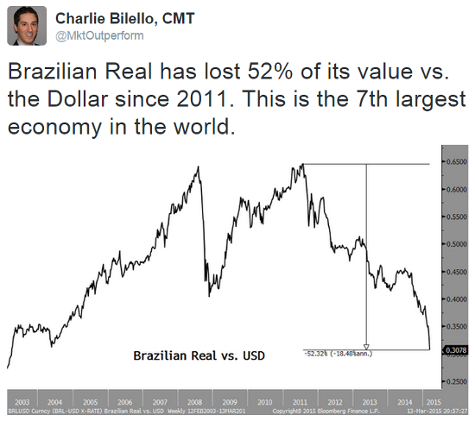
As for Greece, the markets are back to betting on a Grexit. The Greece ministers have pushed too hard. Call the divorce lawyers.
Greece’s short-term bond yield has shot up above 20% again as nervousness over the country’s stand-off with the eurozone continues to mount. The three-year Greek bond yield fell to almost 12 percent in late February, thanks to a provisional deal to tide it over while negotiations over a new bailout continued. But talks have turned increasingly rancorous as Greece has demanded war reparations from WWII and the EU has continued to insist that the radical ruling Syriza party must continue to adhere to austerity measures agreed in previous rescue agreements. That has sent Greece’s short-term bond yields – those most sensitive to speculation that the country could fall out of the eurozone – climbing higher again.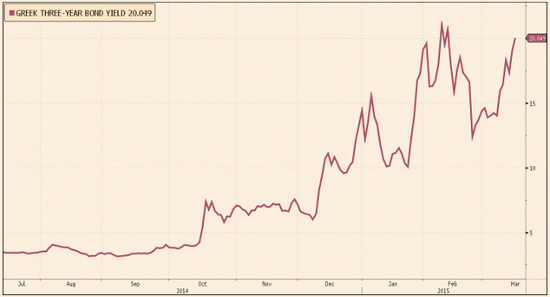
The Energy bounce happened in February. I hope that you eliminated or significantly reduced your exposures into the bottom tick buying frenzy that occurred…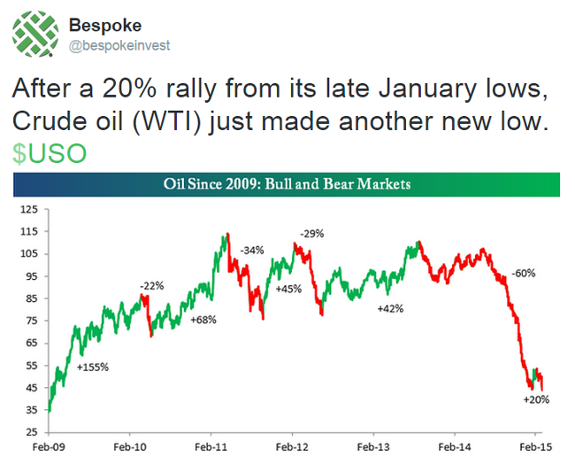
…Because Energy equities are down to their last support level…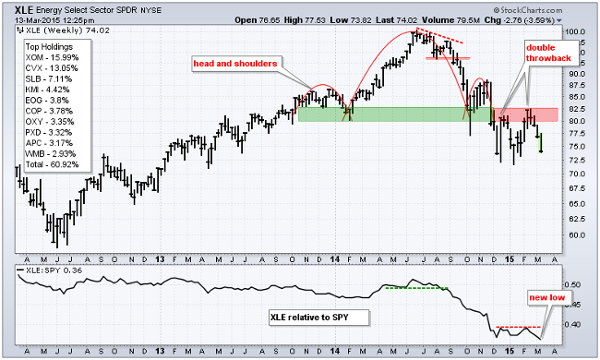
…And Crude storage capacity continues to fill up…
A record surplus in U.S. crude inventories may soon strain the nation’s storage capacity, renewing a slump in prices and curbing its output, according to the International Energy Agency. The IEA boosted estimates for U.S. oil production this year as cutbacks in drilling rigs have so far failed to slow its output. Crude inventories threaten to fill tanks, with the nation’s largest oil-storage hub in Cushing, Oklahoma 70 percent full, the agency said. The IEA raised its 2015 estimate of global oil demand by the most since it was introduced in July. “Stocks may soon test storage capacity limits,” said the Paris-based adviser to 29 nations in its monthly market report. “That would inevitably lead to renewed price weakness, which in turn could trigger the supply cuts that have so far remained elusive.
Falling Oil & Gas prices now significantly impacting State revenues…
The decline in spot oil prices in the last half of 2014 and first month of 2015 has reduced oil and natural gas production tax revenues in some of the largest oil- and natural gas-producing states. Texas, North Dakota, Alaska, and Oklahoma are four of the five top oil- and natural gas-producing states, and they derive a significant share of their unrestricted operating revenues from taxes on oil and natural gas production. Although California produces more oil than both Alaska and Oklahoma, its economy is much larger, making it relatively less affected by changes in oil and natural gas prices and production.
And everyone has Houston under the microscope to see how this downturn will impact them versus the mid 80′s and 2008-09…
Houston is not pretty, but it thrives. In the decade to 2010, the population of its metro area grew more than that of any other American city. Between 2009 and 2013 its real GDP increased by 22%, more than twice as fast as the American economy as a whole. Its growth infuriates new urbanists who insist that dense, walkable places such as Manhattan or San Francisco are the future. The question is, can Houston continue to thrive in an oil bust?
Over two-thirds of the growth in crude oil production in the United States between 2009 and 2014 took place in Texas. As well as refineries and drillers, oil brings office jobs: ConocoPhillips (NYSE:COP) and Halliburton both have their headquarters in Houston, as does BP (LONDON:BP)’s America division. Exxon Mobil (NYSE:XOM) is building a huge new campus near The Woodlands, a wealthy suburb north of the city. In the past, oil-price gains and job gains have kept in close step (see chart).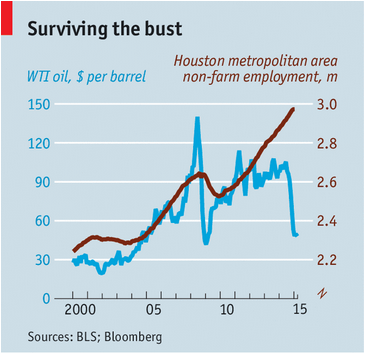
While lower Energy prices are a significant positive to the U.S. Economy, their short-term direction continues to have an impact on Stock prices…
For the week, Oil prices and Energy equities led the Sectors and overall markets lower…
More broadly, falling Energy prices and the rising U.S. Dollar also clipped the Emerging markets and most Commodity dependent economies…
One sign of strength in Equities is the outperformance of the Small Caps…
Note above the even greater strength in Small Cap Growth stocks. Small Caps have more domestically weighted revenue streams and thus are less impacted by falling foreign currencies. Also the backdrop for M&A remains in place for bigger companies looking to finance and acquire external growth.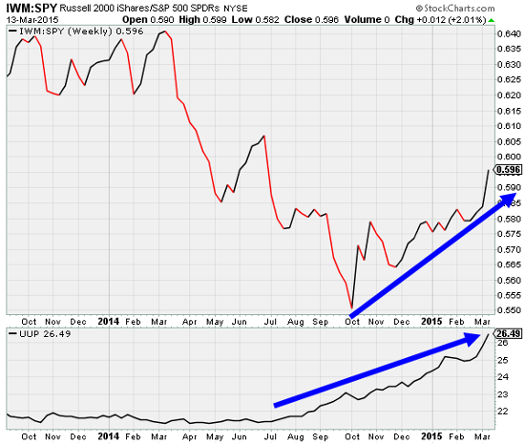
A quick look at The Good, The Bad, and The Ugly for short term Sector performance…
Financials, Consumer Cyclicals, and Healthcare make the GOOD category…
…Technology, Industrials, and Materials make the less than good category…
…Staples, Energy, and Utilities easily get the UGLY category…
Keep an eye on the data for the Billion Prices Project because the numbers are turning up…
One of the biggest economic questions facing the U.S. economy in 2015 is this: Will measures of inflation veer into deflationary territory, or will prices firm? The Billion Prices Project, which scrapes the Internet daily to capture changing prices online and has often foreshadowed subsequent changes in official price indexes, shows a sharp turn upward in measures of inflation, albeit from a low starting point.

Could increasing prices be confirming the U.S. economic strength which we see in rising short term yields?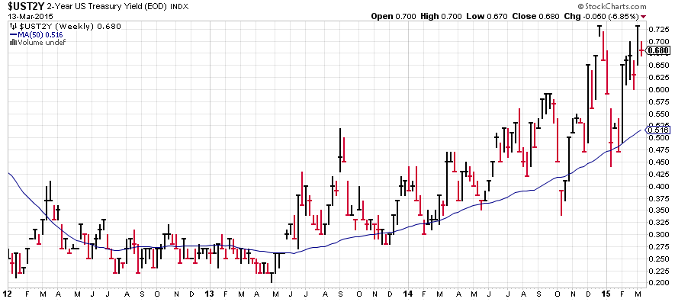
Are Retail Sales being pummeled by the weather or just Online Retail Sales?
And it’s worth noting that the winter freeze in the U.S. didn’t clamp down on consumption altogether. If you want a real read on the U.S. appetite for purchasing during February check out nonstore—that is, online—retailers, who saw sales surge 2.2% in February.
Speaking of Retail Sales, here comes a new product for your wrist…
Apple Inc (NASDAQ:AAPL).’s new smartwatch may be a tough sell, with 69 percent of Americans indicating they are not interested in buying the gadget, according to a Reuters/Ipsos poll. However, the survey also showed limited awareness of the watch. The poll was taken after Apple Chief Executive Tim Cook rolled out the product on Monday, and only about half of respondents said they had heard news of the timepiece in the last few days. Also, in an encouraging sign for Apple, roughly 13 percent of survey respondents who did not own an iPhone said that they would consider buying one in order to buy an Apple Watch, which needs an iPhone to work fully.
While many are not interested in the Apple Watch, Time magazine thinks that the product will sell just fine in one larger market…
While Americans will compare the Apple Watch’s $349-$17,000 price tag to the cost of consumer electronics, Chinese consumers are more likely to stack it up against luxury timepieces. The worldwide median price of a luxury watch is about $10,700, according to DLG. That means the Apple Watch Sport (starting $349) and Apple Watch (starting $549) are inexpensive by comparison, while the gold and silver Apple Watch Edition models that start at $10,000 aren’t crazy purchases.
While the Chinese buy up all of Apple’s Watches, Californian’s will be buying trying to corner the market in Cologne, Perfume, and Axe body spray…
Data from NASA satellites show that the total amount of water stored in the Sacramento and San Joaquin river basins — that is, all of the snow, river and reservoir water, water in soils and groundwater combined — was 34 million acre-feet below normal in 2014. That loss is nearly 1.5 times the capacity of Lake Mead, America’s largest reservoir. Statewide, we’ve been dropping more than 12 million acre-feet of total water yearly since 2011. Roughly two-thirds of these losses are attributable to groundwater pumping for agricultural irrigation in the Central Valley. Farmers have little choice but to pump more groundwater during droughts, especially when their surface water allocations have been slashed 80% to 100%. But these pumping rates are excessive and unsustainable. Wells are running dry. In some areas of the Central Valley, the land is sinking by one foot or more per year… Right now the state has only about one year of water supply left in its reservoirs, and our strategic backup supply, groundwater, is rapidly disappearing. California has no contingency plan for a persistent drought like this one (let alone a 20-plus-year mega-drought), except, apparently, staying in emergency mode and praying for rain
Dyson is getting into batteries. This could get very interesting for your home of the future…
Dyson, the company famous for its bagless vacuum cleaners and bladeless fans, is investing $15m in a U.S.-based start-up as it looks to capitalise on the next generation of battery technology to improve its products… “It’s the most promising [battery] technology we’ve come across,” said Sir James Dyson, the British engineering entrepreneur, of Sakti3’s solid-state batteries which double the energy density of today’s lithium-ion ones… Sakti3, which was founded in 2008 by former University of Michigan engineering professor Ann Marie Sastry, believes its lithium-ion batteries are a safer version of those in current use. Instead of containing a liquid electrolyte, which can cause chemical reactions that can degrade the battery or cause fires, they consist of solid lithium electrodes. The U.S. start-up also says its more powerful batteries are smaller, longer-lasting and in time could be cheaper to manufacture
If your clients own/manage assets in the Hospitality & Leisure industry, tell them to closely monitor and address their TripAdvisor reviews…
Those reviews carry demonstrable weight. A study by Cornell University’s Center for Hospitality Research found that for every percentage point a hotel improves its online reputation, its “RevPAR” (revenue per available room) goes up by 1.4 percent; for every point its reputation improves on a five-point scale, a hotel can raise prices by 11 percent without seeing bookings fall off. This has been a boon for smaller, midpriced, independently owned hotels. “Twenty years ago, the brands owned the sense of quality,” says Bjorn Hanson, a professor at New York University’s Tisch Center for Hospitality and Tourism. “If I stayed at a big-name hotel, I knew what I was getting.” That sense of confidence in quality, argues Hanson, has been supplanted by TripAdvisor. Not only can there be variation within a brand, but suddenly that quirky hotel that was once the obscure favorite of a single guidebook gets lifted to market prominence. Thanks to TripAdvisor, a formerly sleepy spot like the Magic Castle Hotel in Los Angeles—ranked number one in the city—is, says Hanson, “able to generate rates and occupancy levels that from a hotel-analyst point of view are quite extraordinary.
Finally, the best book that I wish that I had read 30 years ago…
If you are an introvert, are married to one, the parent of one, a manager, or a teacher – then you will find this book useful. If you have a high school or college introvert in your life, do them a favor and buy them this book. Thanks to the many of you who recommended this to me.
At least one-third of the people we know are introverts. They are the ones who prefer listening to speaking, reading to partying; who innovate and create but dislike self-promotion; who favor working on their own over brainstorming in teams. Although they are often labeled “quiet,” it is to introverts that we owe many of the great contributions to society–from van Gogh’s sunflowers to the invention of the personal computer.
Passionately argued, impressively researched, and filled with indelible stories of real people, Quiet shows how dramatically we undervalue introverts, and how much we lose in doing so. Taking the reader on a journey from Dale Carnegie’s birthplace to Harvard Business School, from a Tony Robbins seminar to an evangelical megachurch, Susan Cain charts the rise of the Extrovert Ideal in the twentieth century and explores its far-reaching effects. She talks to Asian-American students who feel alienated from the brash, backslapping atmosphere of American schools. She questions the dominant values of American business culture, where forced collaboration can stand in the way of innovation, and where the leadership potential of introverts is often overlooked. And she draws on cutting-edge research in psychology and neuroscience to reveal the surprising differences between extroverts and introverts.
The information presented here is for informational purposes only, and this document is not to be construed as an offer to sell, or the solicitation of an offer to buy, securities. Some investments are not suitable for all investors, and there can be no assurance that any investment strategy will be successful. The hyperlinks included in this message provide direct access to other Internet resources, including Web sites. While we believe this information to be from reliable sources, 361 Capital is not responsible for the accuracy or content of information contained in these sites. Although we make every effort to ensure these links are accurate, up to date and relevant, we cannot take responsibility for pages maintained by external providers. The views expressed by these external providers on their own Web pages or on external sites they link to are not necessarily those of 361 Capital.
